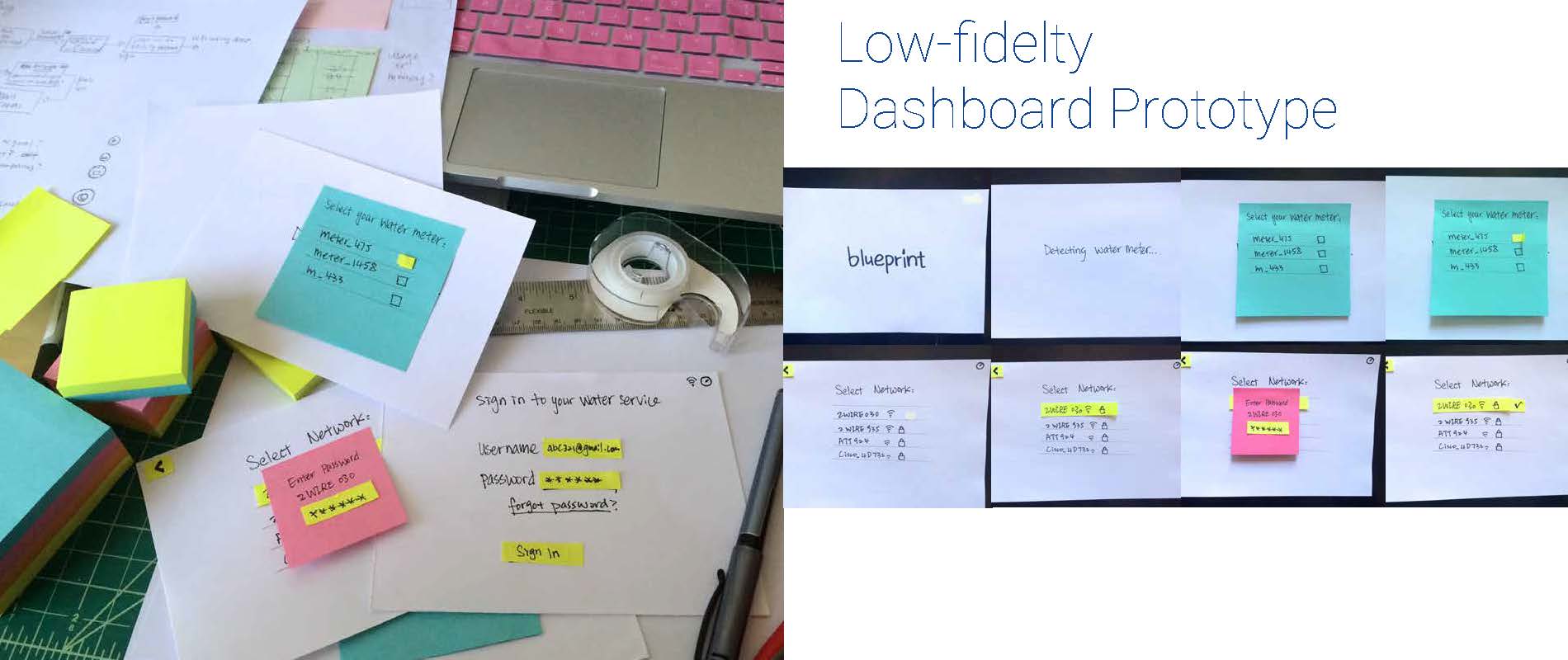BRIEF
Create a product concept to address opportunities around the internet of things to address issues arising from the California drought.
Deliverables:
Product Mission & Goals
Business & User Success Metrics
Data Driven Personas
Screen based Medium Fidelity Prototypes
SKILLS
UX Research
Product Strategy
Information Architecture
Wireframing
Prototyping
Usability Testing
PRODUCT MISSION
Providing users with real time water usage data the blueprint product ecosystem enables users to monitor and adjust their daily consumption habits.
BUSINESS GOALS
Help our customers reduce their water usage
Penetrate the SoCal home market for utility management products
Develop a customer base of residential customers and utility pilot partners
BUSINESS METRICS
Reduce customer water usage by 10%
Secure 20% of the SoCal residential market
Secure Glendale Water and Power & Pasadena Water Power as Pilot Partners
Secure 5% of SoCal commercial market
INITIAL USER NEEDS
Reduce water usage by City defined goal
Real time notification in the case of unusual activity
Be able set quantifiable goals and meet them
USER SUCCESS METRICS
75% success rate in helping users meet city defined reduction goals
Reduce costs of water damage caused by unusual activity by 50%
Increase 'mean time to kitchen drawer' by one year
EXPLORATORY RESEARCH
Our initial vision was to create a solution that enabled utility companies to manage the large amounts of data generated by the implementation of smart water meters.
We kicked off our exploratory research by clustering initial assumptions around utility, commercial and residential users building persona skeletons then scheduled interviews with representatives of each.
Exploratory Research Takeaways:
Residential: They want to conserve water but do not know where and how. Residents have difficulty tracking data so they need an easy solution.
Small Business: They are more in need of data because of scale and cost.
Utility: Adoption of new technology by residential users is a challenge for the utility companies, so much so that they've coined an inhouse metric, 'mean time to kitchen drawer.'
Our initial assumptions were to target utility companies and commercial property managers, but we discovered a saturated market and an ecosystem with significant barriers to entry given the stakeholder landscape.
ENABLING TECHNOLOGY
ITRON smart water meter
UX RESEARCH
Our exploratory research helped us narrow our focus to the area of greatest impact, residential users passionate about reducing their water consumption, but with limited understanding of how. After several rounds of user interviews and in home visits we developed a set of behaviorable variables that enabled us to create formal data driven personas.
DASHBOARD PROTOTYPING
Our initial solution was to develop a stand alone dashboard to meet the needs of two of our personas, Katie and Rob. Katie is a mother who needs a simple visualization of her usage so she can educate her two children on their impact. Rob is a data junkie who tracks everything and is interested in a deeper level of usage data.
DASHBOARD USABILITY TESTING
VALIDATING THE Water Compost CONCEPT
In our user research we identified Nicole. Nicole is a 'conspicuous conserver' who is very comfortable investing heavily in eco-friendly vehicles and modifications to her home to better conserve water.
She is also prone to collect her coworkers recycling at work as well as sort her neighbors recycling for them to 'make sure it gets recycled properly.' The irony is that although she's willing to put in a lot of effort to conserve, her Mint account has been activated but not setup and her bills are all on autopay because she's more interested in the 'fun stuff.'
This lead us to develop a product focused solution that lets Nicole compost her unused gray water and reuse it in other ways around the house. As this solution was beyond the scope of the project, but Nicole is a valuable customer we conducted a diary study with potential users to evaluate the product's viability for further development.
WATER COMPOST PROTOTYPING
NEXT STEPS
An emphasis on publishing research findings in key trade publications and exploring ways to contribute to the state wide effort to reduce water consumption are obvious next steps.
Our efforts to further develop the water compost will continue to yield human centered insights that are not really a focus of the governmental research effort. Finding a mentor to shepherd the research and product development effort will be key in navigating next steps as well. This research is bound to shed light on other product opportunities as well.
More specifically, understanding how water composting can be universally adopted in the state of California is key within the context of a systems approach to designing a water infrastructure. Because, like a tube of tooth paste, the infrastructure relies on a set capacity of water flowing through it, turning off the faucet and using less is leading to a build up of solid waste and other infrastructural challenges and will lead to other problems.
In other words, keeping the water flowing is key to avoid infrastructural issues, so maximizing the use of the water pulled from the system will become increasingly important.






















